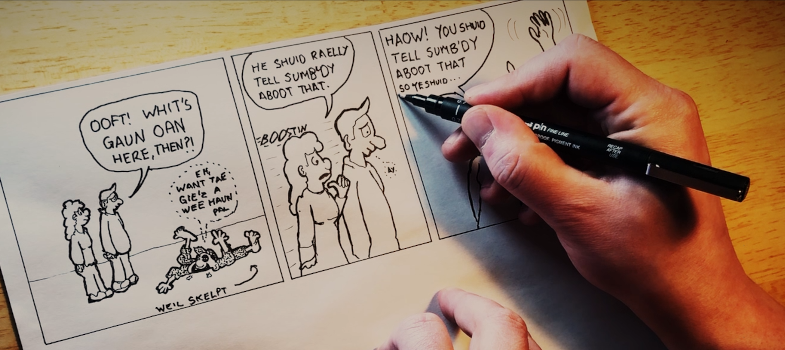Scots Language, Creativity and the Expressive Arts

1. Introduction
In this unit you will have the opportunity to learn from the much-celebrated artist Gerda Stevenson. Not only has she written the content of the unit, but she is also sharing her own Scots language poetry throughout – specifically from her 2018 collection Quines.
The unit is written in the first person as it provides a unique perspective of Stevenson's work. She has crafted a rich unit of material for practitioners to engage with in their own study, including recordings of her reading the poems she discusses. At the same time, we hope that you will find many opportunities for using parts of this unit in your own classroom for your pupils’ learning of and about Scots.
We at the Open University and Education Scotland were delighted to gain such access to both Stevenson’s poetry, many other of her creative projects, as well as to the thinking, planning and writing process which lead to the creation of her fabulous collection of poetry celebrating women from across both Scotland’s landscape and the history of Scotland.
This theme of traversing across both space and time is of particular importance for practitioners using Scots language in learning settings. Stevenson’s creative output is so vast and diverse that we cannot simply describe her as a poet, she requires the title of an artist in the truest sense of the word. There will be opportunities throughout the Unit for you to make links between Scots language and Scotland the place, between poetry and history, between people and ideas, between artforms, and across a great many aspects of the Curriculum for Excellence – particularly the Expressive Arts. All too often the study of Scots language is confined to literature, but as you have been learning from studying this course so far, Scots goes much further than only Literacy and the English classroom. It is a way into Song, Music, Textiles, Painting, Drama... explore this unit to read plenty about each of these and more!
Because Stevenson has included ample interesting and unique content in her unit – particularly audio content for you to listen to, but also media clips to watch, paintings or textiles to study – we would encourage you to take your own notes throughout on the great many ways such material could be used in your classrooms, even though you might not teach an Arts or Social Science subject.
Despite the different format, this unit, as all others, includes the application of what you study here, engagement with research and the reflection on your teaching for the professional recognition award for this course.
Key learning points:
to engage with Scots language in various forms, registers and voices within a variety of art forms, including poetry, drama and song, with particular focus on my poetry collection Quines;
to learn how one art form can connect with and provide inspiration for another – e.g. across literature, music and the visual arts, including painting, textiles, sculpture, film, and theatre;
to understand the role of various elements as stimuli for creativity – place and landscape; connecting with Scottish literature; poetic form; voice and register; imaginative leaps; research; dictionaries and translation;
to engage with local communities to create art, using interviews and museum artefacts as a basis for drama and song.
